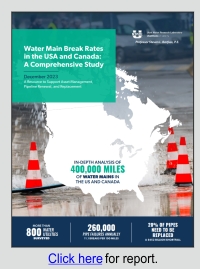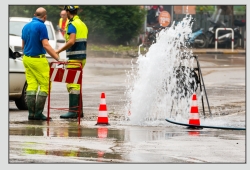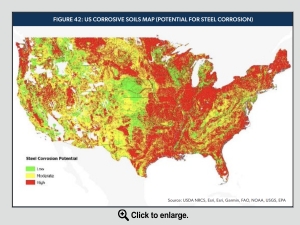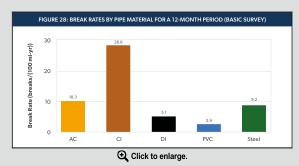|
New Utah State University Water Main Break
Report: An Asset Management Tool for Utilities
 Please
see below the press release issued by Utah State University regarding their
latest water main break study. The report provides valuable information on water
pipe condition and operation and can assist with asset management, water
infrastructure planning, and pipe replacement decision-making. The goals are to
control operating costs, reduce service level impacts, and minimize health risks
to customers. The study is of interest to water utility professionals, policy
makers as well as local lawmakers and enables utilities to benchmark pipe
material performance. Please
see below the press release issued by Utah State University regarding their
latest water main break study. The report provides valuable information on water
pipe condition and operation and can assist with asset management, water
infrastructure planning, and pipe replacement decision-making. The goals are to
control operating costs, reduce service level impacts, and minimize health risks
to customers. The study is of interest to water utility professionals, policy
makers as well as local lawmakers and enables utilities to benchmark pipe
material performance.
New Report Says Lack of Funding for
Critical Water Mains is $452 Billion, Over 260,000 Breaks Annually
LOGAN, Utah, February 27, 2024 /PRNewswire/
-- Utah State University (USU) has published a third extensive study of commonly
used water pipe materials titled, "Water Main Break Rates in the USA and Canada:
A Comprehensive Study."
According to primary researcher, Professor Steven L. Barfuss, P.E., one of the
most important indicators for identifying failing pipelines is water main break
rates. Pipe performance continues to be impacted by soil corrosivity, and the
replacement of asbestos cement and cast iron pipe is creating a shift in
predominant pipe materials.
"Our infrastructure is aging, causing water pipelines to deteriorate," says
Professor Barfuss. "Utilities can use this report to assist with asset
management and facilitate water infrastructure planning and pipe replacement
decision-making. The goals are to control operating costs, reduce service level
impacts, and minimize health risks to customers."
 Over
800 utilities were surveyed and almost 400,000 miles of pipe data were analyzed,
representing 17% of the estimated 2.3 million miles of water mains in the United
States and Canada. This data set is large enough to provide accurate information
on the characteristics of aging pipe infrastructure and the costs of repair and
replacement. Over
800 utilities were surveyed and almost 400,000 miles of pipe data were analyzed,
representing 17% of the estimated 2.3 million miles of water mains in the United
States and Canada. This data set is large enough to provide accurate information
on the characteristics of aging pipe infrastructure and the costs of repair and
replacement.
"Notably, the report shows that 20% or 452,000 miles of water pipes in the US
and Canada are beyond their useful lives and need to be replaced but have not
been due to lack of funds. This represents a $452 billion shortfall. In 2012,
utilities reported that only 8% of installed water mains were beyond their
useful lives, so this is a growing problem," Professor Barfuss adds.
USU published similar studies in 2012 and 2018. The 2023 report references the
previous studies to analyze changes over time. The sample size for this study is
almost three times larger than the previous 2018 USU water main break survey. In
terms of pipe mileage, this is the largest study in the US and Canada of its
kind. Previous studies have been based on much smaller sample sizes and
consequently may have reduced accuracy in
data reporting.
 Major findings and benchmarks include: Major findings and benchmarks include:
- The US and Canada experience 260,000 water
main breaks annually, representing $2.6 billion in annual repair costs.
- Utilities reported the average failure age of
water pipe is 53 years. Notably, 33% of water mains are over 50 years old,
representing 770,000 miles of piping.
- In 2018, cast iron and asbestos cement
together represented 41% of all installed water mains. In 2023, the combined
length for these materials is 33%, a reduction of almost 8%. PVC pipe length
increased by 7% and ductile iron remained
approximately the same.
-
 Material usage varies significantly across
geographic regions, suggesting that selection of pipe materials is often based
on preference. Material usage varies significantly across
geographic regions, suggesting that selection of pipe materials is often based
on preference.
- A total of 86% of cast iron pipe is over 50
years old and 41% of asbestos-cement pipe is more than 50 years old.
- The estimated average water loss to leakage is
11%.
- Overall failure rates decreased by 20% since
2018, which seems to correlate with reduced inventory of cast iron and
asbestos cement pipe, both of which have the highest break rates.
- A reconfirmed major finding is that polyvinyl
chloride (PVC) pipe has the lowest break rate when compared to cast iron,
ductile iron, steel, and asbestos cement
pipes.
- Almost 86% of water pipes in the US and Canada
are less than 12 inches in diameter.
-
 Smaller pipes (12-inch in diameter and less)
fail five times more than larger pipes (14-inch and larger). Smaller pipes (12-inch in diameter and less)
fail five times more than larger pipes (14-inch and larger).
- A total of 75% of utilities reported corrosive
soil conditions, which is consistent with the 2012 and 2018 USU
studies – demonstrating the importance of corrosion mitigation for water pipelines.
- Ductile iron pipe has over six times more
failures in highly corrosive soils compared to low corrosive soils.
- The percentage of utilities approving
ductile iron has decreased by 8% from 86% in 2018 to 78% in 2023. Steel pipe
has shown a 6% increase in acceptance from 38% to 44%. Acceptance rates for
other pipe materials have remained about the same.
- Almost 44% of utilities conduct some form of
regular condition assessment of water mains.
To view the full report, including the full set of
key findings and its methodology,
click here.
 This
comprehensive study contributes to the continuing efforts of the EPA's Aging
Water Infrastructure (AWI) research, the US Conference of Mayors' Water Council, and the asset management and water infrastructure condition assessment efforts
of the American Water Works Association (AWWA) and American Society of Civil
Engineers (ASCE). This
comprehensive study contributes to the continuing efforts of the EPA's Aging
Water Infrastructure (AWI) research, the US Conference of Mayors' Water Council, and the asset management and water infrastructure condition assessment efforts
of the American Water Works Association (AWWA) and American Society of Civil
Engineers (ASCE).
Steven L. Barfuss, P.E., is
a Research Professor at USU in the Civil and Environmental Engineering
Department and an Associate Director at the Utah Water Research Laboratory (UWRL),
a world-renowned water research facility. Professor Barfuss has over 37 years of
research experience at UWRL and has published numerous peer-reviewed articles in
national and international journals. He also has considerable experience in the
hydraulics of pipelines and pipe failures.
|
Regards,
|
|
|
Bruce Hollands
President & CEO | Uni-Bell PVC Pipe
Association
201 E. John Carpenter Freeway, Suite 750 |
Irving, TX 75062
T. 972.243.3902 ext. 1019 | F. 972.243.3907
www.uni-bell.org
  
|
|